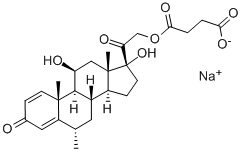Methylprednisolone Sodium Succinate is the sodium succinate salt of a synthetic glucocorticoid receptor agonist with immunosuppressive and anti-inflammatory effects. It is converted into active prednisolone in the body, which activates glucocorticoid receptor-mediated gene expression. This includes inducing the synthesis of the anti-inflammatory protein IkappaB-alpha and inhibiting the synthesis of nuclear factor kappa B (NF-kappaB). As a result, proinflammatory cytokine production, such as IL-1, IL-2, and IL-6, is down-regulated, and cytotoxic T-lymphocyte activation is inhibited. Therefore, an overall reduction in chronic inflammation and autoimmune reactions may be achieved.
6α-Methylprednisolone 21-Hemisuccinate is a glucocorticosteroid used in anti-inflammatory medication in the treatment of spinal cord injuries.
6α-methylprednisolone 21-hemisuccinate sodium salt has been used to investigate glucocorticoid-induced osteonecrosis under hypoxic conditions in the MC3T3-E1 osteoblast cell line using a cell cytotoxicity assay, flow cytometry and western blotting.
ChEBI: Methylprednisolone sodium succinate is a corticosteroid hormone.
A-Methapred (Abbott);
A-Methapred (Hospira); Solu-Medrol (Pharmacia & Upjohn).
Glucocorticoid with slightly longer half-life than that of prednisolone.
Methylprednisolone Sodium Succinate is commonly given by injection and common side effects include: injection site pain/redness/swelling, nausea, vomiting, heartburn, headache, dizziness, difficulty sleeping, appetite changes, increased sweating, acne, increased blood sugar, sore throat, fever, chills, cough, white spots in the mouth. Serious side effects manifest as abnormal weight gain, menstrual disorders, bone/joint pain, easy bruising/bleeding, mental/mood changes, fast/slow/irregular heartbeat, stomach/intestinal bleeding symptoms, seizures, liver problems, and symptoms of severe allergic reactions. Contact your doctor if any of these serious adverse symptoms occur.



